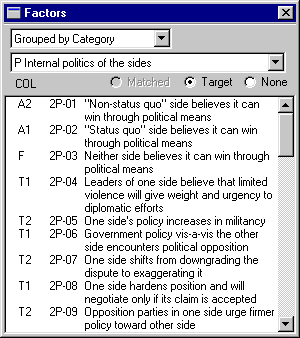Coding Factors
Once phases have been identified, specific factors may exert an influence over the dynamics of the situation by "pushing" it either toward or away from the threshold of the next phase. Factors represent economic, political, ethnic, military, social, or psychological events, conditions or perceptions that could reasonably be shown to have exerted pressures, in varying degree, on the course of a conflict. CASCON's factors were developed empirically from case histories. Factors derive from one or more specific statements about particular post-World War II conflict situations, representing elements deemed relevant in real life by historians, diplomats, or other experts on those conflicts. These specific statements were then inductively combined and generalized into CASCON factors, by replacing specific names and places with generic phrases and by merging similar statements into common factors. The factors encompass the influential variables available from this special form of theorizing about the dynamics of local conflict.
 There are 571
factors in CASCON with 176 factors in Phase 1, 189 in Phase 2, and 206 in Phase 3. Within
each phase, factors are grouped into ten factor categories
by subject matter. Factors are assigned a factor number beginning with the phase
number and category letter code and then a two-digit number within that group. For
example, factor "3M-06" is the sixth factor in the military-strategic category
in Phase 3. Note that a factor applies only to a single phase. If the same condition is
relevant in another phase, there will be a separate factor with a different factor number.
There are 571
factors in CASCON with 176 factors in Phase 1, 189 in Phase 2, and 206 in Phase 3. Within
each phase, factors are grouped into ten factor categories
by subject matter. Factors are assigned a factor number beginning with the phase
number and category letter code and then a two-digit number within that group. For
example, factor "3M-06" is the sixth factor in the military-strategic category
in Phase 3. Note that a factor applies only to a single phase. If the same condition is
relevant in another phase, there will be a separate factor with a different factor number.
CASCON provides a standard list of factors for all cases. For each case, a factor coding is used to indicate whether a factor is present and, if present, what effect it has. Each of the cases in CASCON database was coded by three experts, usually one or two scholarly authorities, perhaps a former diplomat, military officer, or UN mediator who had been associated with the case, as well as by one in-house coder at MIT. Where codings diverged, most were reconciled through a set of decision rules, with remaining instances being resolved collegially by the staff.
The factors can be thought of as a checklist of questions to ask about the case. Every factor has been significant in some past case, but it may or may not be relevant to the case at hand. In going through the factors for a phase, the first decision is whether each factor was present or absent at that phase. If present, a factor may have a neutral effect, or it may influence the situation toward or away from "worsening" or "escalation," that is, from the use of violence. For factors identified as present and influential, the degree of influence is rated on three levels. The nine choices for factor codings are:
| T3 | Major influence toward use of military force | |
| T2 | Some influence toward use of military force | |
| T1 | Little influence toward use of military force | |
| N | Neutral, present in the case but no influence in either direction | |
| A1 | Little influence away from use of military force | |
| A2 | Some influence away from use of military force | |
| A3 | Major influence away from use of military force | |
| F | False, or not present in the case | |
| -- | No information available, or not yet coded | |
When a new case is opened, all factors are marked as "no information." In coding a case some factors can be skipped over altogether. For example, for a case in Phase 2, none of the Phase 3 factors is applicable. Similarly, if there is no disputed territory, category D can be ignored entirely. For the rest, the "no information" coding is an indication of additional aspects of the case that may need further investigation. CASCON's grouping or filtering capabilities can be used to quickly identify "no information" factors. The coding tool also has a button that skips to the next uncoded factor.
Hint. One technique for coding a case is to go through the factor list twice. On the first pass, only the presence or absence of a factor is considered. Factors are marked N for present or F for not present. On the second pass, all the factors marked N are evaluated for influence on the case. Generally, the "major" codings T3 and A3 should be used sparingly to indicate the most salient forces driving the case. Other factors that tilt in one direction or the other can be marked as "little" or "some" depending on the user's judgment of their degree of influence.